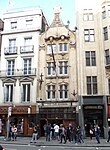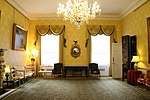Waterloo and Whitehall Railway
1865 establishments in England1867 disestablishments in EnglandAbandoned underground railway projects in LondonPneumaticsRailway companies disestablished in 1867 ... and 5 more
Railway companies established in 1865Transport in the City of WestminsterTransport in the London Borough of LambethTunnels underneath the River ThamesUse British English from March 2017

The Waterloo and Whitehall Railway was a proposed and partly constructed 19th century Rammell pneumatic railway in central London intended to run under the River Thames just upstream from Hungerford Bridge, running from Waterloo station to the Whitehall end of Great Scotland Yard. The later Baker Street and Waterloo Railway followed a similar alignment for part of its route.
Excerpt from the Wikipedia article Waterloo and Whitehall Railway (License: CC BY-SA 3.0, Authors, Images).Waterloo and Whitehall Railway
Whitehall, London Covent Garden
Geographical coordinates (GPS) Address Nearby Places Show on map
Geographical coordinates (GPS)
| Latitude | Longitude |
|---|---|
| N 51.506041666667 ° | E -0.12663333333333 ° |
Address
Whitehall 55
SW1A 2HP London, Covent Garden
England, United Kingdom
Open on Google Maps










